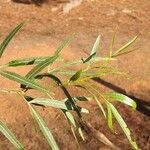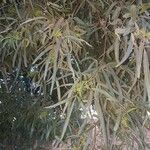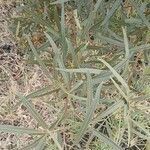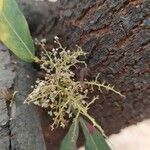An shrub or evergreen tree. The branches droop. The crown is rounded. It can be 9 m high but also a shrubby bush. It is erect and has a single stem. It has a twisted dark brown trunk. The branches are slender and reddish. The leaves have 3 long narrow pointed leaflets. The leaflets are dark green and shiny above and pale below. They are narrowly sword shaped. They narrow to both ends. They are 6-13 cm long and the central leaflet is the largest. The midrib is raised on both sides. Male and female flowers are on separate plants. The flowers are very small and pale green. They occur in loose, much-branched sprays. They can be in the axils of leaves or at the ends of branches. The fruit is round and slightly flattened and lopsided. They are 4-5 mm across. They are green but turn yellowish-brown when ripe. It has a large seed. There is a thin layer of flesh. The outer skin is shiny brown. The fruit are edible.
Tree or shrub, 1-12 m high; semi-evergreen; bark dark brown to blackish, rough, irregularly fissured; branches and branchlets reddish, pendulous. Leaves petiolate, trifoliolate; leaflets sessile, subcoriaceous, glabrous, often glutinous, dark olive-green above, pale yellowish green below, narrowly lanceolate, margins entire, slightly thickened. Inflorescence axillary and terminal panicles, lax, much branched; flowers crowded. Flowers small, pale greenish yellow, sweetly scented; corolla lobes oblong; styles widely separated, recurved, persistent. Flowering time Apr.-Sept. Fruit a drupe, oblate, ellipsoid, glabrous, shiny, dull yellow to brown, sometimes sticky.
Quite glabrous; leaves on long petioles; leaflets sessile, lanceolate-linear, acuminate, mucronate, quiteentire, paler and parallel-veined beneath; panicles axillary, shorter thanthe leaves; drupe lentiform, glabrous. A little tree with the habit of a Willow. Bark grey and smooth. Wood reddish-brown, hard and very tough. Branches virgate. Petioles terete, furrowed above, 1-2 inches long. Leaflets 4-5 inches long, 4-6 lines wide or smaller, sessile or the intermediate one shortly petiolulate. Panicles glabrous, 1-2 uncial, of the length of the leaves or shorter; pedicels capillary. Flowers very minute. Drupe rather dry, size of a pea.
Shrub or spreading tree, up to 12 m high. Bark very dark reddish brown when old, fissured. Leaflets sessile; blade linear to narrowly ovate, margins entire, venation prominently penni-parallel; terminal leaflet generally > 8 x longer than broad, (24-)70(-120) mm long. Flowers: corolla pale greenish yellow; May-Jul. Fruit an ellipsoid, glabrous drupe.
Dioecious, semi-evergreen, large shrub or tree, up to 12 m tall, with dark fissured bark. Leaves trifoliolate, leaflets sessile, linear to lanceolate, dark olive-green above, pale yellowish green below, ± glutinous. Flowers greenish yellow. Drupe round, shiny, dull yellow to brown.
Shrub or spreading tree, up to 12 m high. Old bark very dark reddish brown, fissured. Leaflets entire; terminal leaflets broadly linear, generally more than 8 times longer than broad, venation prominently penni-parallel. Flowers pale greenish yellow.
Dioecious, evergreen, large shrub or tree to 12 m with dark, fissured bark. Leaves trifoliolate, leaflets sessile, linear to lanceolate. Flowers greenish yellow. Drupes round, shiny.





